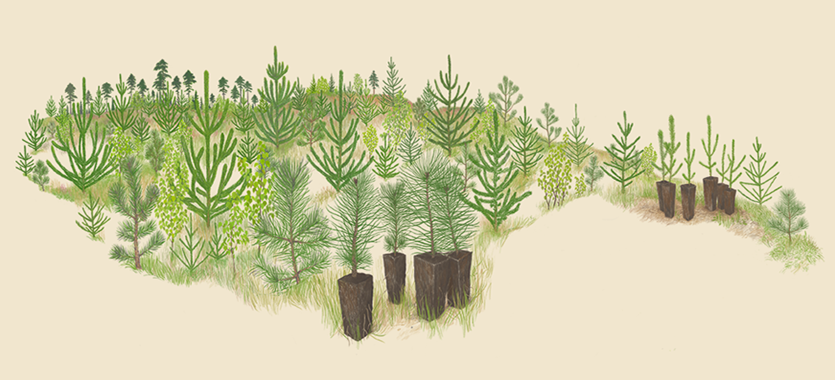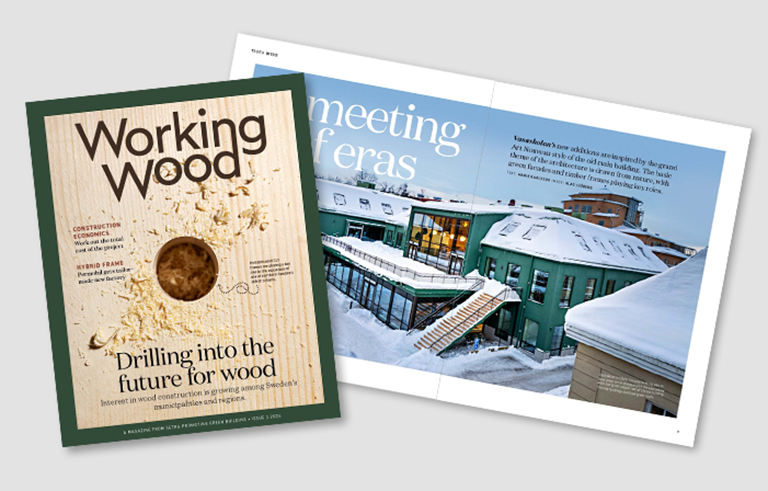The material properties of wood vary between and within different wood species. The external features of a tree, including crookedness, thickness and the arrangement of the branches, affect the fi-nal product, such as planks and boards. Inside the trunk, factors such as the length of the fibres and the angle of the trunk are important. Crookedness and low angles can create problems with unstable, warped planks during sawing.
“Large, thick branches mean large knots inside the trunk, which negatively affect the strength. The wood industry needs logs of large volumes that are ideally straight, stable and don’t have too many knots,” explains Mateusz Liziniewicz, a forestry and processing researcher at the Forestry Research Institute of Sweden (Skogforsk).
Forest management also affects the characteristics of the trees. Choices such as natural regeneration or planting and how thinning is carried out will affect the trees. The greatest opportunity to make an impact is at the planting stage and the beginning of the tree’s life.
After clearing and thinning, you are largely bound by what you have created.
Through research and breeding, Skogforsk is trying to find tree varieties with properties that can withstand our current and future climate. One way is to choose offspring from trees that grow well in a wider range of climatic conditions.
“We’re testing materials in different places. Cloned seedlings and offspring from trees growing in southern Sweden are being planted a little further north, and seedlings from the north are being planted in the south. We then select the individuals from all the trials that performed best overall. Hopefully, they’ll have the greatest chance of doing well in the future,” says Mateusz.

Wood is wood, right?
Does it matter what species of wood is used for different products? And if so, what determines the different characteristics of the northern species of spruce and pine? Forest researcher Mateusz Liziniewicz explains the differences between spruce and pine and how they are affected by the conditions in which they grow.
Spruce
The spruce is Sweden’s most common tree. Spruce is the predominant tree species in building and construction, but it is used in many different contexts. The pale wood of spruce is relatively soft, light and porous, and is also known as whitewood. In addition to construction, spruce is widely used in the paper and pulp industry, where its long fibres produce a strong paper that is well suited to paperboard production, for example. Crooked spruce trees with large branches can cause problems in the sawmill industry. The preference is for straight logs, without too thick knots, which provide strong and stable planks.
Pine
Pine, also known as redwood, has dark, rot-resistant heartwood at the centre and lighter sapwood around the outside. The wood, considered easy to process, is denser and harder than spruce. It is known that pine’s knot pattern depends on genetics, and breeding work deliberately avoids trees with branches at a low angle to the trunk. Pine is processed into a wide range of products, including furniture and construction timber for wooden windows, doors, cladding and mouldings.
How does geographical location affect the properties?
Wood from southern Sweden is generally denser, stronger and more durable than wood from the northern parts of the country, where the forest is instead slow-grown and fine-grained. The place where a tree grows plays a major role in its characteristics. Factors such as temperature and humidity have an impact.
Text: Marie Karlsson
Illustration: Astrid Linnéa Andersson
Published: 2022-08-09




